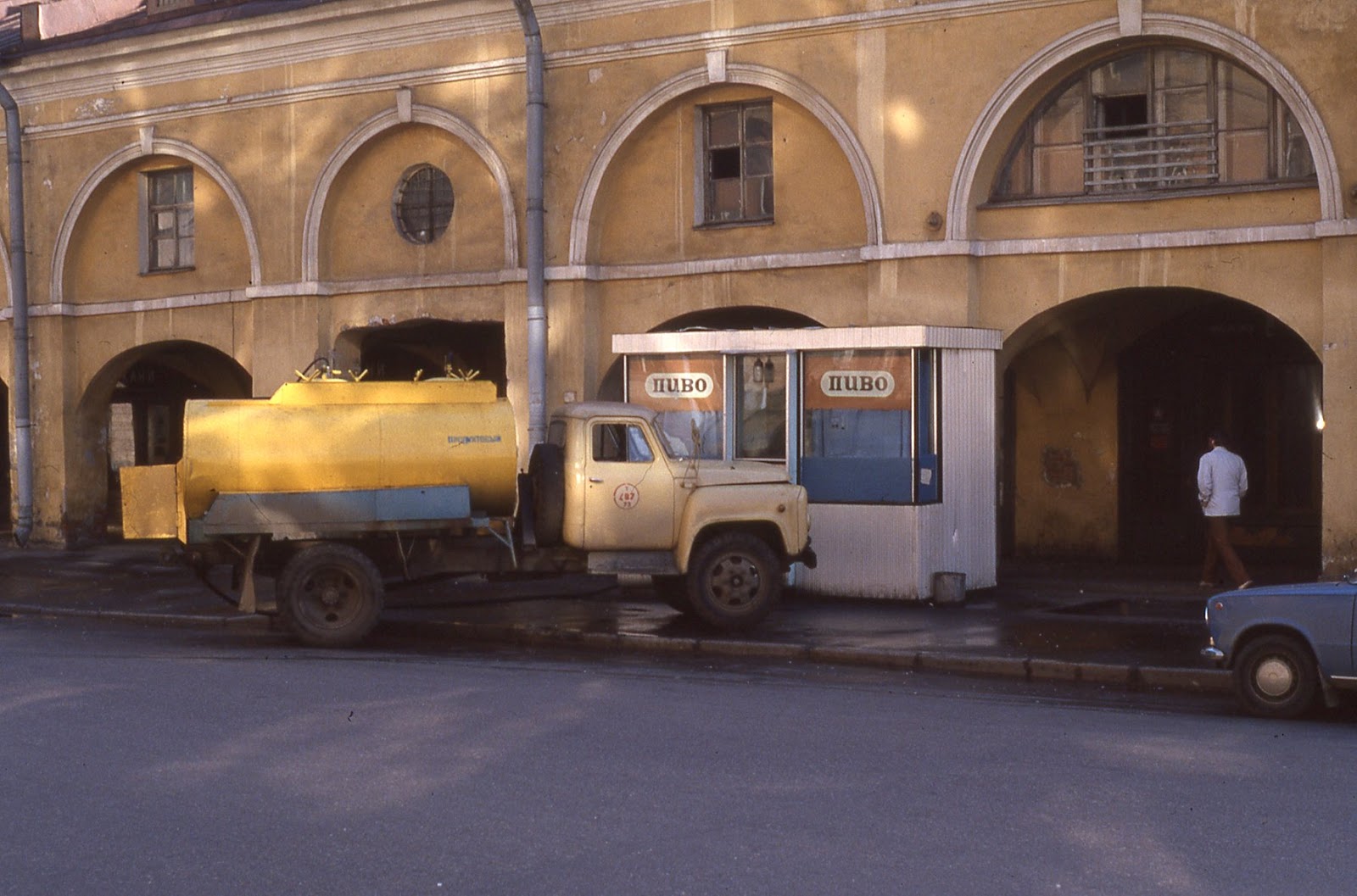
Last installment: 30 years ago today: The Trinity Lavra of St. Sergius, a renowned monastery in what was then Zagorsk.
—
In the unstaged photo above, you see a much younger Publican nursing a bottle of genuine Soviet vodka, canalside, somewhere in Leningrad USSR. Strictly speaking, neither of these geographical entities exist any longer.
It was around 1:00 a.m. on July 3, 1987. We hadn’t missed the White Nights by much. Also pictured are Kim Wiesener, our Danish group tour guide, and his bosom buddy Allan Gamborg, who was leading a tour group of his own. The groups overlapped in Leningrad, and one thing led to another.
At the time, I could not have foreseen that Barrie and I would remain friends with Kim and Allan (and later their close friend Kim Andersen) all these years since. In many respects it is through them that I know Europe.
Serendipity truly is everything, though looking back on it now, two more mundane considerations take precedence: The mosquitoes patrolling that canal were the size of wasps — and I’d had only an hour or two of sleep in two days.
The brutal truth of the matter is that a stupendous intake of alcohol, crummy hotel beds and an overall lack of sleep are to blame for my inability to construct a trustworthy narrative of the post-Moscow portion of our 1987 tour of the USSR and Poland.
Granted, it’s been 30 years. Then again, I’m not sure I could have done much better in August of ’87. For two weeks, I let myself go to seed. It was an organized tour, and someone else was doing the heavy lifting. Hitherto, I’d been traveling alone and always charged with my own upkeep. This took discipline. On the tour, I’d pre-paid for beds and meals, and there were pros around to do my chores. It was like the proverbial busman’s holiday.
Consequently, I wasn’t paying close enough attention. Moreover, considering that Barr is one of history’s consummate storytellers, the narrative of the group tour tended to rest with him. He complied merrily, though not always with a journalist’s attention to detail. These many years later, it’s impossible to separate fact from fiction, but I’ll do my best.
The group came to Leningrad from Moscow via an overnight “sleeper” train. I’m glad the train slept, because most of the rest of us didn’t. The train arrived so very early in the morning on July 2 that even allowing for the bus time to the hotel, it stood to be two to three hours before the rooms were ready for occupancy.
Most of our cohorts collapsed to nap on the floor, using baggage as pillows. However, my compatriot Nick already had an ambitious plan for roaming. His surname is Russian, and the family roots go back to imperial times when Leningrad was St. Petersburg. Nick also had a street address for (I believe) his grandfather’s house — long since passed from the family, but hopefully available for viewing and documentation.
We looked at a map, found the rough location of the street, linked together the public transportation connections, and realized we could manage it on our own. Off we went on a bus (or tram?) to the nearest subway station, and then into the center of the city.
The house had survived, or at least a building was standing at the address in question. Nick photographed it. On the way back, we saw this.

There were streetside kiosks selling пиво (beer) just like flowers or sausages. When the beer ran out, someone had to change the keg, and this is how it was done — with a miniature beer tanker truck, pumping beer into the underground tank, not unlike a gas station.
Later in the morning, having reported back to the hotel for instructions and being told that time was being allotted for group recuperation, Nick and I found our rooms and then went back out into the streets. This time we found an active beer stand with a full tank.

There were three, maybe four community mugs at the window. We paid a few cents per mug for four mugs of beer. The attendant cleaned the mugs by spraying them with water. They were filled with draft lager, and we chugged them as fast as we could, because after all, there were 25 thirsty men (almost never women in such places) waiting behind us for their turn.
The beer was flat. That’s all I remember about it.
I seem to recall an afternoon group walkabout in the historic center. It may have included the Hermitage museum in the former Winter Palace. If so, I didn’t go inside, as it had been on my itinerary in 1985. Or, maybe I did. All those years; all those beers.
(Note: It didn’t. The Hermitage tour occurred the following day)
Seeing as I’ve written about Leningrad previously, those readers with an interest in the city can delve into it by way of these links.
Euro ’85, Part 29 … Helsinki beneath my feet, but Leningrad on my mind.
Euro ’85, Part 30 … Or, as it was called at the time, Leningrad.
Euro ’85, Part 31 … Leningrad in three vignettes.
Euro ’85, Part 32 … Leaving Leningrad.
Scattered images from July 2 include the pedestrian walkway without a floor, which kept walkers on their toes.

The Soviet brutalist Leningradsky Dvorets Molodezhi Hotel, built in 1975, obsolete in 1987 and still intact as of 2016.

The train of friendship might have been ours, but alas, the banner was unfurled for another visiting group.
I’ve always cherished this shot of Barr with the toy car.

At some point, with a belly full of vodka, I must have slept.
Was there food?
—











